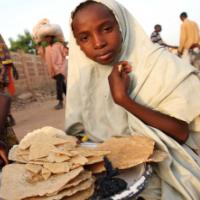It's been called a perfect storm, the convergence of bad weather, tight supplies and increasing demand that is responsible for driving up food prices across the globe by an average 21 percent in the past year. The United Nations Food and Agriculture Organization contends that developing countries may end up paying even more.
Price volatility and shocks have long been defining characteristics of the world agriculture market. But this year, consumers have seen simultaneous price increases across the board in nearly every commodity.
Throughout most of the developed world, higher grocery bills luckily remain only a nuisance, although fears of "agflation" abound. In sub-Saharan Africa, where people spend a higher percentage of their paychecks on food, the story is much different. In Burkina Faso, staple products -- sorghum, millet and maize -- shot up nearly 60 percent in October and November. In response to a doubling of the price of flour, rioters smashed shops in Mauritania, leaving one person dead and wounding 17; at least 50 people were injured in price-related protests in Morocco; even once-pacific Senegal has seen demonstrations against rising prices for milk, sugar, rice and bread.

